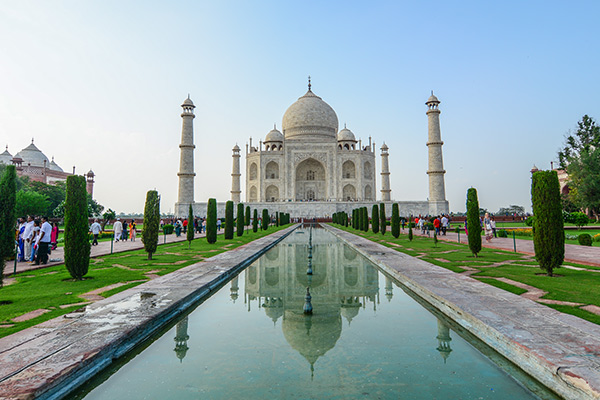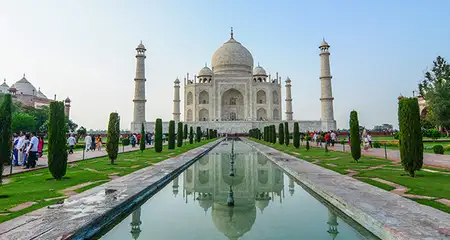Situated on the banks of Yamuna, the Taj Mahal in Agra is a monumental ode to eternal love. This 17th-century mausoleum was built for Mumtaz Mahal by her husband and Mughal Emperor Shah Jahan. Regarded as one of the most beautiful buildings in the world, the Taj brilliantly represents the height of Mughal architecture and grandeur. Such is its beauty that it has been recognized as one of the Seven Wonders of the Modern World. Now, do you need any more reasons to include it in your itinerary when booking your hotels in Agra for a trip? We guess not!
So, here’s everything you should know about the Taj Mahal including its history, entry fee, timings, architecture, nearby attractions, and lesser-known facts.
Taj Mahal Information:
| Location | Agra, Uttar Pradesh |
| Timings | 30 minutes before sunrise to 30 minutes before sunset; closed on Fridays |
| Entry Fee | ₹ 50 for Indians; ₹ 1100 for foreigners; ₹ 540 for citizens of SAARC and BIMSTEC countries; free for children below 15 years of age |
| Main Mausoleum Entry Fee | ₹ 200 per head |
| Night Entry Timings |
|
| Night Entry Fee |
|
| Still Camera | Free, but photography prohibited inside the main mausoleum |
| Years of Construction | 1632 to 1653 |
| Commissioned by | Shah Jahan |
| Type | Mausoleum |
| Status | UNESCO World Heritage Site, One of the Seven Wonders of the Modern World |
| Architectural Style | Mughal |
| Architect | Ustad Ahmad Lahauri |
| Material Used | A blend of Islamic, Persian, and Indian architectural styles |
| Cost of Construction | 32 million rupees |
| Area | 42 acres |
Taj Mahal: History
The Taj Mahal, the grandest mausoleum the world has ever seen, was commissioned by Shah Jahan, the Mughal Emperor, for his favorite wife Mumtaz Mahal. The construction of the mausoleum commenced in 1632, around a year after Mumtaz died, on the banks of the Yamuna River. Though the main mausoleum was constructed by 1643, it wasn’t until 1653 that the whole complex was completed. Unfortunately, the emperor was overthrown from power and imprisoned by his son Aurangzeb in 1658. Shah Jahan spent his last days in imprisonment in the nearby Agra Fort from where he looked at his marvellous creation. When he died in 1666, he was buried inside the Taj Mahal, beside his loved wife.
When the Jat rulers of Bharatpur raided Agra in the 18th century, they invaded the Taj and plundered it. During the Revolution of 1857, this memorial suffered damage at the hands of the British soldiers and officials, who removed the precious stones from its walls.
The Taj Mahal underwent massive restoration works in the early part of the 20th century under the command of Lord Curzon, the then Viceroy of India. After independence, the monument came under the aegis of the Government of India.
Taj Mahal Architecture
A universally admired masterpiece of art, the Taj Mahal combines elements from Islamic, Persian, and Indian architectural styles. The monument covers an area of 42 acres, bounded by crenelated walls on three sides and the Yamuna on the fourth side. It was constructed using white Makrana marble sourced from Rajasthan. Thousands of precious and semi-precious gemstones were also used to enhance the beauty of the memorial.
The Taj Mahal stands on an elevated square plinth that has four minarets standing at the four corners. The symmetrical building housing the crypts has an arch-shaped entryway that sits below a colossal dome and finial. Inside the main hall of the mausoleum, you can see the false sarcophagi of Shah Jahan and Mumtaz Mahal. The actual tombs are located inside a locked chamber at a lower level.
While the external decorations of the monument testify to the Mughal craftsmanship, the interiors are equally dazzling. The octagon-shaped inner chamber features jali bordering and quotations from the Quran on the cenotaphs and intricate decorative details featuring twining vines, flowers, and fruits, highlighted with 28 kinds of precious and semiprecious stones. Though the base and casket are delicately decorated, the crypts where the main bodies are kept are rather plain, in keeping with the Islamic tradition.
It took more than 22000 skilled artisans, laborers, painters, stonecutters, and a huge amount of 32 million rupees to build the Taj Mahal. Apart from the mausoleum, the Taj complex houses a mosque, a museum, a guest house, and ornamental gardens.
Book Budget Hotels near Taj Mahal
Taj Mahal Garden, Agra
The Taj is surrounded by a sprawling 980 sq. ft. Mughal garden or Charbagh. Raised pathways divide the garden into 16 sunken flowerbeds. An elevated marble water tank placed between the main gate and the tomb adds to the beauty of the whole place. The Taj Gardens were originally modeled on the famous Persian gardens. However, when the colonial rulers took possession of the Taj, they changed the garden’s landscape and made it look like the lawns in London. It is one of the famous places to visit in Agra.
Taj Mahal Museum
Within the Taj Mahal complex stands the small but significant Taj Museum, which is home to several original miniature paintings from the Mughal era. One of the highlights of this museum is the pair of 17th-century ivory portraits of Shah Jahan and his wife. The museum also houses several Caledon plates that are known to change color or break into pieces if poisoned food is served on them.
- Museum Timings: 10:00 am to 5:00 pm
- Museum Entry Fee: Free
Taj Mahal: Today
Today, no trip to Agra is deemed complete without a visit to the Taj Mahal. Every year, the memorial attracts around 7 to 8 million visitors who come to admire this incredible work of art and marvel at its beauty. In 1983, it was declared a World Heritage Site by UNESCO. The monument was selected as one of the winners of the New Seven Wonders of the World initiative (2000-2007).
Things to See in the Taj Mahal Complex
Taj Mahal complex comprises of several beautiful structures and attractions, including:
- A red sandstone mosque situated on the west of the mausoleum
- Mehmaan Khana or assembly hall located on the east of the mausoleum, identical to the mosque
- Jilaukhana or forecourt zone
- Bazaar streets or two identical streets that start from the east and west gates and lead up to the Jilaukhana
- The Great Gate, Gate of the Mausoleum or Darwaza-i-Rauza
- East Gate (Fatehabadi Darwaza), West Gate (Fatehpuri Darwaza), and South Gate (Sidhi Darwaza)
- The Taj Museum
Lesser Known Facts about Taj Mahal, Agra
- In the Persian language, Taj Mahal means the Crown of Palaces.
- The interiors of the Taj Mahal have a reverberation time of 28 seconds. It means if you say anything inside this place, it will echo for 28 seconds.
- In 1942, the Taj Mahal was disguised under scaffoldings to minimize the threat of air attacks by the Japanese during World War II. The same tactic was followed during the India-Pakistan wars of 1965 and 1971.
- The minarets of the Taj are built to tilt outwards to prevent the tomb from suffering any damage in case of calamities like earthquake.
- The Taj Mahal is taller than the Qutb Minar by about five feet.
- On 8th November 2000, the famous Indian magician PC Sorkar Jr. created an optical illusion that made the memorial vanish in front of the public standing there.
- George Harrison, the lead guitarist of the famous Beatles music band was among the first selfie-takers at the Taj. He made use of the fish-eye lens for the purpose.
- The Taj appears pinkish at sunrise, milky white in the evening, and shines with a golden glow under the moonlight.
- There are 99 names of Allah inscribed in calligraphic style on the tombs.
- The original site of the Taj Mahal was supposed to be Burhanpur in Madhya Pradesh where Mumtaz Mahal died. But due to a lack of white marbles in that area, Agra was chosen as the final spot for the memorial.
Book Hotels – Budget Hotels in Agra | Couple Friendly Hotels in Agra
Attractions near Taj Mahal
- Agra Fort (3.1 km)
- Jehangir’s Palace (3.1 km)
- Jama Masjid (4.1 km)
- Mankameshwar Temple (4.5 km)
- Tomb of Itmad-Ud-Daulah (6.7 km)
- Chini-ka-Rauza (7.2 km)
- Mehtab Bagh (7.8 km)
The Taj Mahal is a timeless love story celebrated in marble. If you are making a tour of the Taj, why not take up a 5 days Golden Triangle tour and explore the other nearby heritage sites as well? We are sure you won’t regret your trip.




























